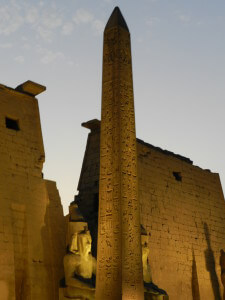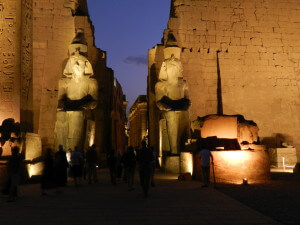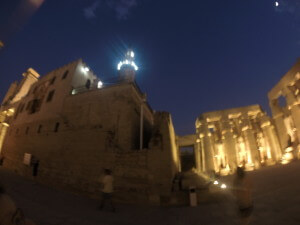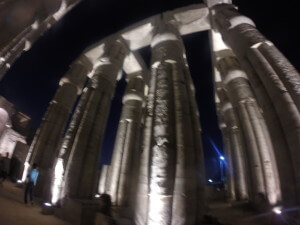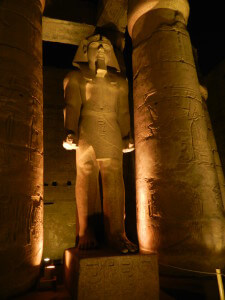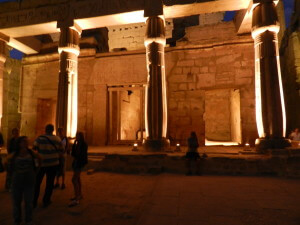Luxor: the last of 4 temples we visited in one day. Anciently, it was connected to the Karnak temple by the avenue of sphinxes. It’s Karnak’s little sister with a beauty all its own.
When we arrive, it’s twilight, but the temple is lit up and has a golden glow about it. Lots of people still mill around. After all, the desert is cooling down from the high of 100 today. Night is my favorite time of day here in Egypt.
We are impressed with the two seated statues of Rameses II and the huge 80-foot obelisk at the entrance. There used to be 2 obelisks, but the “cheeky French” have the other one, as our guide Aladdin said. (The other obelisk stands in the Place De La Concorde in Paris.)
Visitors may wonder why there is a mosque inside the walls of Luxor. Well, a Muslim in antiquity tricked the queen into giving him as much land as he could cover with a camel’s hide. He proceeded to cut the hide into a long thin strip, then boxed out an area big enough for a building.
So a lovely mosque sits in one corner of the court about 20 feet above the level of the Luxor temple flagstones. At the time of the mosque’s construction, the temple was covered with about 20 feet of sand. Definitely different.
I love the columns in the Solar court; they are unique. Instead of a flat surface covered with relief carvings of Egyptian gods and animals, they represent bunches of papyrus plants. So it looks roughly like a stylized bunch of celery with a closed tulip at the top. If you cut a cross-section, it would look like a flower with 8 rounded petals. The court was designed to suggest the columns support the sky. (The ancient Egyptians weren’t self-important at all, were they?)
In the temple, 11 colossal statues once stood between the columns of the peristyle court. Now there are 4. They were built by Amenophis III but usurped by Rameses II. We noticed in our travels Rameses II usurped a lot of monuments from previous pharaohs. He is everywhere.
We are free to explore the columns, the side rooms off the courts, and the ‘holy of holies’ where only the high priest or Pharaoh could enter. Basically a shrine to the god the temple is dedicated to. They used to have a statue of the goddess Mut there. The priest performed rituals there and changed the statues’ outfits regularly. I found that interesting.
As we leave, we cast a last glance at the beautiful complex. It is dark now, but with spotlights on the columns, statues and outside walls, the temple glows with a soft golden light in the warm Egyptian night.
